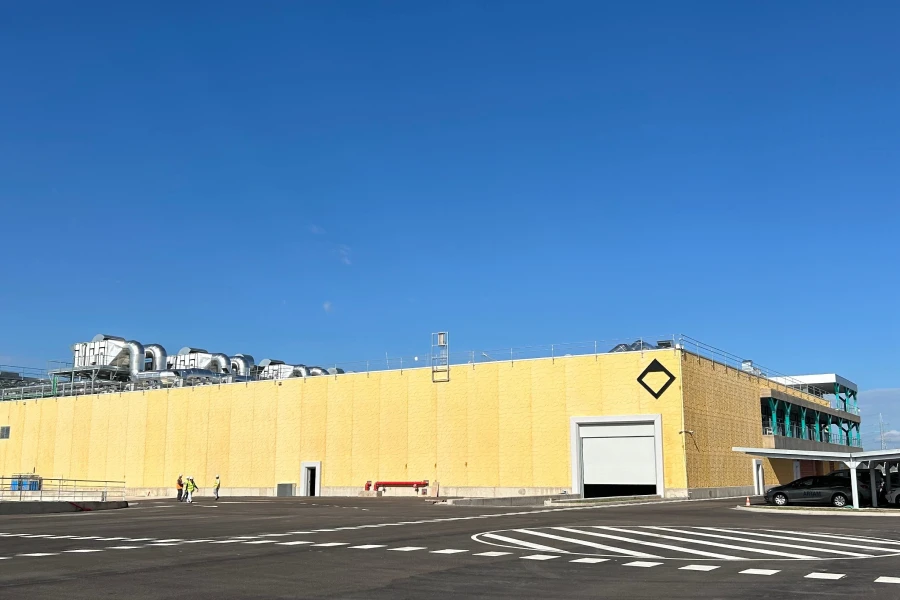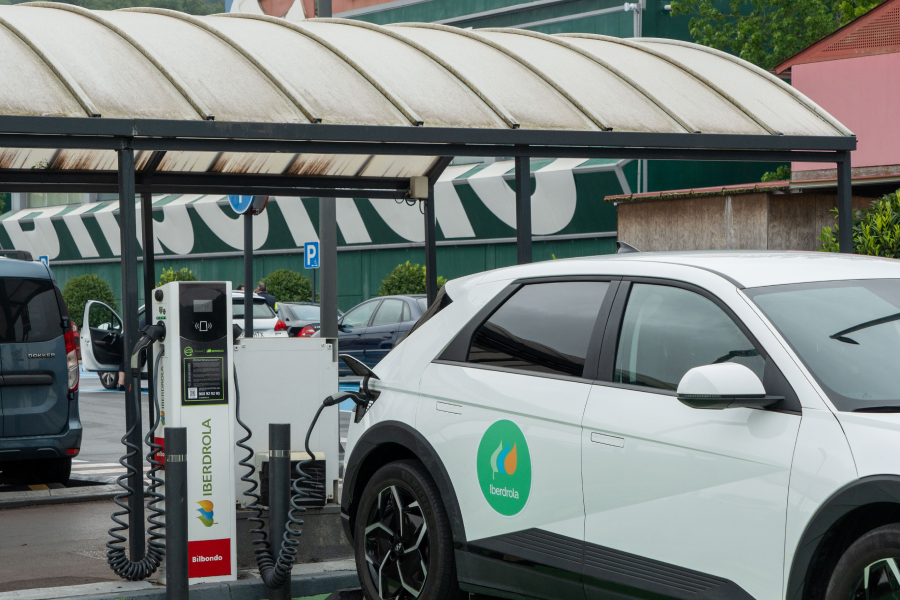CARBON FOOTPRINT IN SPAIN
Everything you need to know about the carbon footprint in Spain
Today, the carbon footprint has become a key indicator for measuring the environmental impact of our actions. As a benchmark in renewable energies, at Iberdrola España we are committed to reducing it in order to tackle climate change and move towards a sustainable future.

From the emissions linked to the transport we choose to the emissions from the production of the goods we consume, the carbon footprint assesses the total amount of greenhouse gases that each action, product or choice generates in our environment. Here, we will explore the types of carbon footprint and how to calculate it, providing a comprehensive overview of its importance and how everyone can contribute to reducing their emissions.
What is carbon footprinting and why is it important?
Buying new jeans or driving your own car. Carbon footprint is a metric that quantifies the total amount of greenhouse gases, such as carbon dioxide or methane, that are released as a result of human activities related to, for instance, electricity generation or transport. This process often involves the use of fossil fuels, which increases their concentration in the atmosphere above normal levels. Due to their chemical composition, greenhouse gases have the capacity to absorb part of the sun's radiation, increasing the average temperature of the earth and thus generating significant alterations in the climate balance.
In 2022, the Spanish economy emitted 304.4 million tonnes of greenhouse gases, according to the National Statistics Institute (INE). These emissions have decreased by more than 25% since 2008, but they increased by 3.1% compared to 2021. Measuring the carbon footprint not only quantifies the problem, but also guides decision-making, both from a personal consumption and business perspective, towards more environmentally friendly practices. By understanding the harmful gas emissions associated with our actions and decisions, we can identify key areas to implement changes that will have a positive impact on the environment.
Types of carbon footprint
A continuación, conocemos las características de cada tipo. The diversity of the carbon footprint is broken down into three key categories: personal, product and corporate. Each plays a crucial role in shaping the overall environmental impact. Below, we look at the characteristics of each type.
Personal carbon footprint
It measures the greenhouse gas emissions associated with a person's individual activities. From household energy consumption to daily commuting, every lifestyle choice contributes to this footprint. Calculating the personal carbon footprint provides a detailed view of how our daily choices affect the environment – allowing us to take concrete steps to reduce our individual environmental impact.
How can you reduce your personal footprint?
We share a series of tips on how to reduce your carbon footprint without making a drastic change to your lifestyle:
-
Opt for renewable energy. They can reduce a person's emissions by an average of 1.68 tonnes of CO2 per year, according to the BBC.
-
Reduce food waste, opt for local production and eat less meat. The latter could save the equivalent of driving 1,866 kilometres.
-
Move in a sustainable way and buy eco-friendly vehicles. Walking and cycling have a neutral impact on the planet.
-
Increase the energy efficiency of your home. Purchase energy-efficient equipment and avoid wasting energy.
-
Raise awareness of the importance of reducing your carbon footprint, both by washing your clothes in cold water and by extending their lifespan.
-
Opt for responsible consumption. Avoid disposable products and recycle.
How can you reduce your personal footprint?
Raise awareness of the importance of reducing your carbon footprint.
Increase the energy efficiency of your home.
Opt for renewable energy.
Reduce food waste, opt for local production and eat less meat.
Move in a sustainable way and buy eco-friendly vehicles.
Opt for responsible consumption.
Product carbon footprint
It takes into account GHGs (Greenhouse Gases) emissions during the stages of manufacture, transport, use and final disposal of a specific product. Thus, it includes how consumer goods contribute to climate change, from the obtaining of raw materials for their production to the end of their useful life.
Company’s carbon footprint
It addresses the impact of harmful gases into the atmosphere generated by a company's operations in all its facets. It ranges from direct emissions in facilities to indirect emissions associated with the supply chain and business activities. It also serves to identify energy efficiency measures and sustainable practices within the company.
The carbon footprint of an organisation along the value chain (Spanish version)
How can companies reduce their carbon footprint?
Both companies and organisations have the capacity to implement measures aimed at significantly reducing their carbon footprint. We highlight several of these below:
-
Commit to renewable energy sources. Research and adopt renewable energy sources to power the company's operations. Transitioning to clean energy can be key to reducing emissions.
-
Promoting energy efficiency. Prioritise energy efficiency by adopting technologies and practices that reduce electricity and fuel consumption.
-
Promote the circular economy. Through the circular economy, you can protect the environment by reducing harmful gas emissions and minimising the consumption of natural resources.
-
Staff awareness. Create awareness programmes for staff, fostering a corporate culture geared towards sustainability and carbon footprint reduction.
-
Optimise the supply and delivery chain. Assesses and optimises the supply chain, collaborating with sustainable suppliers and promoting responsible practices throughout the chain.
The carbon footprint of the municipalities of Spain
The carbon footprint of municipalities in Spain is an essential indicator that reflects the direct and indirect environmental impact of local activities. It is influenced by two determining factors: the distribution of the population and the degree of rurality. As these emissions come from individual sources such as car transport or home heating, the understanding of their geographical distribution is limited, which complicates the implementation of effective reduction measures.
According to the map of total annual CO2 emissions elaborated by the Matrix Foundation and based on the analysis of diffuse greenhouse gas emissions of more than 8,000 municipalities in Spain, 90% of localities present an annual emission rate of less than 32 kt CO2-eq. Furthermore, most of the municipalities with low GHG emissions are located in the northern half of the peninsula, with the exception of the centre, municipalities near the coast and some other large areas.
Spanish municipalities that produce the least emissions
Navaescurial (Ávila), Gistaín (Huesca), San Roque de Riomiera (Cantabria), Rábanos (Burgos), Viniegra de Arriba (La Rioja), Torralba del Pinar (Castellón) and Valsalobre (Cuenca) stand out as the 10 municipalities in Spain that contribute the least to the climate change. This is the conclusion of the research carried out by Greenpeace and included in the "HablaRural" report, which analyses the activities to which the total surface area of all the municipalities in Spain is devoted. The study shows that the ten municipalities have the presence of green areas and well-preserved ecosystems.
The analysis highlights the importance of rural areas as a response to the climate emergency and the biodiversity crisis. In contrast to urban areas, rural areas contribute 34% more to curbing climate change and up to 20 times more to biodiversity conservation at the national level.
Challenges to reduce the carbon footprint in Spain
Reducing the carbon footprint in Spain presents several challenges ranging from the need for structural transformations to changes in individual behaviours. Some of the key challenges include:
-
Energy transition and dependence on fossil fuels. Spain faces the crucial challenge of reducing its dependence on fossil fuels by promoting an effective transition to renewable energy sources.
-
Sustainable transport and green mobility. Transforming the transport sector is essential to reduce emissions, requiring the widespread adoption of electric vehicles and efficient public transport alternatives.
-
Energy efficiency in buildings. Improving energy efficiency in existing buildings and adopting sustainable building practices are key challenges to reduce the carbon footprint associated with the real estate sector.
-
Sustainable agriculture and land use management. Addressing emissions from agriculture and sustainably managing land use are significant challenges that require the promotion of more eco-friendly agricultural practices.
-
Public awareness and behavioural change. Fostering environmental awareness and promoting changes in individual behaviour, such as reducing consumption and adopting more sustainable practices, is necessary to achieve a society with a smaller carbon footprint.
How to calculate your carbon footprint
On the internet, there are different guides or free tools created by companies and institutions allowing us to determine our personal carbon footprint, such as the carbon footprint calculator created by the United Nations, which takes into account aspects of our home, the transport we use and our lifestyle.
At Iberdrola España, we have also created our own carbon footprint calculator to help businesses estimate and reduce their carbon footprint efficiently. To do so, simply select the type of activity, consumption data (electricity and other energy sources), and indicate whether you have a fleet of vehicles or the level of efficiency.
How Iberdrola España can help you reduce your carbon footprint
At Iberdrola España, as a leading company in the energy sector in Spain, we have a firm intention to reduce our carbon footprint through our sustainable actions and practices. This is reflected in the creation of Carbon2Nautre (C2N), a company dedicated to offsetting the carbon footprint with global solutions based on nature, enhancing biodiversity and promoting a sustainable economy.
In addition, we plan to fix and capture more than 61 million tonnes of CO2 in natural carbon sinks, thanks to the promotion of ecosystem conservation and restoration projects on more than 100,000 hectares, mainly in forests.
Related information








